It’s long been known as “America’s sports car,” but despite having some fine attributes, the Chevrolet Corvette has long lagged that global sports car benchmark, the Porsche 911. So, when we got our first look at the all-new, seventh-generation ‘Vette during a sneak preview in a well-guarded conference center last December, we were left wondering whether the folks at General Motors might have finally taken the challenge seriously and were set to give Porsche a run for the money.
True, from a financial standpoint, the 2014 Corvette Stingray wins hands-down. You can get a fully-equipped Chevy for around $72,000, or barely two-thirds the price of a similarly well-contented Porsche Cayman, never mind the 911. But when it comes to sports car cred, price takes a back seat to other numbers like horsepower, power-to-weight ratios, cornering forces and the like.
The good news, as we recently experienced during a long day’s run through the hills and dales of Central California, is that the 2014 Chevrolet Corvette Stingray stands up on every count. No wonder the maker is finally confidant it can gain traction for the new 2-seater beyond our shores. The latest incarnation of America’s sports car is now good enough to be a global player that just also happens to be a good bargain.
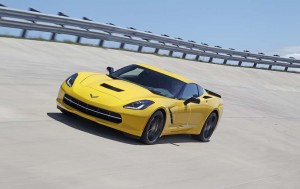
The new Corvette features a new mode control dial that covers conditions varying from Comfort to Track.
The outgoing C6 Corvette, which has been in production since 2005, was perhaps the first in generations to suggest that Chevrolet could really produce a world-class sports car. But at least on paper, the new C7 clearly is something the competition should be worried about.
Ironically, the car almost never made it to the street. Officially, the new model is the result of a 3.5-year development program. But the project was repeatedly delayed as General Motors slipped into bankruptcy. Ironically, suggests Corvette Chief Engineer Taedge Juechter, that may have been a good thing because it allowed the engineering team to access improved technology and the styling team to push through what they felt was a better design than originally approved.
(Chevy counts on Corvette halo to help build brand buzz – and vice versa. Click Here for more.)
The new model is roughly the same size as the outgoing ‘Vette – with approximately the same footprint as a Porsche 911. The numbers: 176.9 inches in length, 73.7 inches in width and 48.8 inches high. The wheelbase measures 106.7 inches.
There’s an all-new hydroformed aluminum frame that shaves significant mass while delivering the stiffest Corvette chassis ever, about 60% over the current C6 model. Even if you were to shave the roof off, it’s 20% stiffer than the current C6, notes Juechter. And, yes, they know that because the platform was designed from the get-go to maximize the performance of the upcoming Corvette convertible without adding any additional bracing.
The new C7 also makes the most extensive use of carbon fiber composites of any GM product to date, including the roof, a move that helps further lower the sports car’s center of gravity, and the hood.
Locking down the design of the new Corvette was a challenging – and at times tedious – affair, according to team members. The delay gave the styling department a chance to push for, and ultimately win approval for, a bolder design that features a swept back roof line that also tapers inward, adding emphasis to the muscular rear shoulders. The new look has won strong kudos – but isn’t entirely without its critics, some arguing that the squared-off taillights now look more like a Camaro than the round lamps of Corvette generations past.
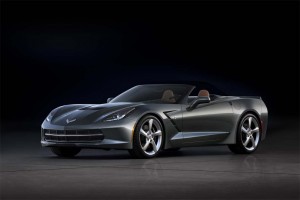
The Corvette Convertible follows the coupe into production in time for next year's drop-top season..
What is winning nothing but praise is the revised interior. Long the weakest element of Corvette design, this part of the development process was kept on a short leash by GM’s global design director Ed Welburn. In fact, the final layout wasn’t approved until less than two years before production was set to begin, a mere blink-of-the-eye in automotive terms.
It was worth the delay. The new interior is everything one might expect, even with the base car, never mind the optional up-market package that envelops the cabin with the sort of leather and Alcantara finishes you’d expect of a supercar at more than twice the price. The centerpiece is a new, reconfigurable TFT gauge cluster that can be shifted rapidly depending upon personal tastes. There’s also a second LCD touch display atop the center stack that Chevy claims is the brightest screen on the market. Switches and knobs are all within easy reach and you don’t have to fumble with that touchscreen to handle functions like radio or climate control.
For the first time ever, the 2014 Corvette will offer buyers a base and an optional sport seat. We spent our time in the standard package and found it more than supportive enough, even under the most aggressive driving conditions, however. But it also maintained a surprising degree of comfort, even after we wrapped up several 100 hard miles.
(Porsche marks 911’s 50th with a special edition. Click Here for a look.)
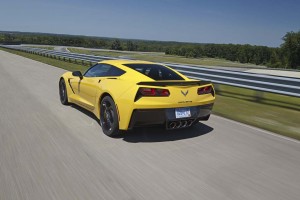
With the optional performance exhaust, the C7 Corvette gets 455 hp, enough to reach 60 in around 3.9 seconds.
And that underscores a critical success of the Corvette development team: what they’ve come up with is a car that could easily serve as a daily driver under all but the worst winter driving conditions. Pushed to its limits, the new Corvette will satisfy the most demanding sports car enthusiast. But for around-town driving, it’s not going to jar the fillings from your teeth. Indeed, you might almost be tempted to call the ride cozy when you’re simply cruising down the freeway.
Give a fair bit of credit for that to the latest-generation Magnetic Ride Control suspension. Corvette was the first to get this technology which relies on a magnetorheological fluid. Basically, that’s a shock absorber oil filled with microscopic ferrite particles. Apply a constantly changing magnetic charge and the fluid instantly changes its viscosity, its ability to flow. In a tight corner, it stiffens up. When you’re coping with potholes, it softens enough to make them largely vanish.
The heart of this beast, however, is the big new LT1 V-8, a 6.2-liter brute that, in base trim, churns out 455 horsepower and 460 pound-feet of torque. That compares to the outgoing 2013 Chevrolet Corvette’s 430 hp and 424 lb-ft – and is in line with the old Corvette Z06. The new C7 also can be ordered with an optional ZR1 package that, among other things, improves the breathing of the LT1 and ups the ante to 460 hp and 465 lb-ft.
Slip into Launch Control and be prepared for the sort of punch to the chest you might expect from an aircraft carrier catapult launch. Even a conventional take-off when the light turn green is a neck-snapping experience. Preliminary numbers suggest you’ll see 60 in around 3.9 seconds – if you can get your hands to work a stopwatch that fast. That’s up with the 911, though the S appears to have it by a nose, as does the new Jaguar F-Type – as long as you’re opting for the supercharged V-8.
(Corvette promises to smoke both of those foes when it adds the upgraded Z07, which is reportedly going to deliver a mind-boggling 600 hp) a bit more than a year from now.
(Click Here for a first look at the Ferrari 458 Speciale.)
Give credit, by the way, to some of the things Chevrolet engineers have done to bring the LT1 into the modern world. That includes direct injection and variable valve timing. There’s also new displacement on demand which will idle half of the engine’s cylinders when power demands are low. That is reflected in the impressive 17 mpg City/29 Highway fuel economy rating for the C7 equipped with a new, 7-speed manual transmission. The EPA estimate, GM notes, reflects an average 28 mpg highway in the default Tour mode, and the driver-selectable, 30 mpg Eco mode.
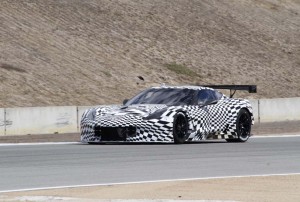
The new racing version of the Stingray, the C7.R, recently broke cover, albeit with a bit of camouflage.
The new 7-speed is clearly the gearbox of choice for serious performance fans. The alternative is a 6-speed automatic. It proved easy to manage and surprisingly responsive when operated manually with the steering wheel-mounted paddle shifters. Nonetheless, Chevy has taken heat for going with only a 6-speed, a situation it reportedly plans to correct in about a year when it is expected to switch over to a new 8-speed automatic – which should boost fuel economy substantially, by the way.
One of the nice new features of the 2014 Corvette Stingray is the center console-mounted mode selector that allows you to dial up five different settings, from Comfort to Track, automatically adjusting a wide range of vehicle settings, including throttle response, suspension damping, shifting and the various brake-based systems, such as stability control. In track mode, you’re essentially on your own. Oh, and another feature that can be dialed in and out is the exhaust. In wide-open setting, you just might scare the guy riding a Harley.
Detroit has always been good at driving power out of its V-8s, but the days when muscle was measured purely by horsepower and 0 to 60 times is long past, and Corvette has finally acknowledged that reality. The good thing is that the 2014 ‘Vette can keep up with its rivals even in the tight and twisties. At around 3450 pounds – depending on configuration – it has an ever-so-slight rear weight bias, at 50.6%.
It also boasts new, custom-designed Michelin rubber that just seems glued to the pavement. The optional e-differential, meanwhile, makes a real difference as we discovered, to our near mortification, coming around a sharp, flat corner hard, only to discover a field of pea gravel had washed onto the tarmac in the recent rains.
Our Vette did slide a bit towards the grass, but where other cars would have had arms and elbows flying akimbo, the Chevy maintained a stunning degree of poise, as if such situations were the norm. The nose pointed right where we intended – and stayed there. After a brief slide, the Stingray simply picked up and headed in the intended direction as if absolutely nothing had happened. Were this the outgoing C6 we might have kissed the fencepost that loomed, menacingly, nearby.
Another intriguing feature that helps in even less urgent situations is a new tire temperature management system that adjusts the control alogorithm for various traction enhancing systems accordingly.
As for the new, electrically assisted, variable-ratio power steering, it provides as much or more feedback as the old car’s hydraulic assist and seems, to our fingertips, to deliver a much more precise and predictable feel for where you’re pointing the nose.
(Green machines? Click Here to check out the flood of new muscle cars coming to market.)
Meanwhile, Chevy completes the package with a well-composed set of Brembo brakes that claim world-class stopping power, bringing the C7 from 60 to 0 in just over 100 feet.
So, what’s it all going to cost you? The base package – which is reasonably well-equipped compared to the typical European competitor – starts at $51,995 plus $995 in delivery charges. That’s a $1,400 jump over the last production C6 but works out to a discount when you consider all the new features. (The Stingray convertible, coming early next year, will carry a base price of $56,995.)
It’s hard to imagine why anyone who can afford the base car won’t opt for the Z51 package– while adding the Magnetic Ride Control — which bumps the price up to $54,795 and also gets you the electronic limited-slip differential, dry-sump oiler, additional brake cooling and more. Add the bigger exhaust which gets you an added 5 hp – at $1,195. All this, incidentally, will still hold your final payment down less than a base Porsche Cayman.
Load absolutely everything you can check and you’re up to around $72,000.
We have to admit being long-time fans of the Corvette. But like those who regularly root for teams like the Detroit Lions, that doesn’t rule out constant disappointment. There were many a generation of ‘Vettes that simply seemed designed for a different era, nay, even a different universe. We began to build hope with the last-generation C6, but the C7 finally returns to the big leagues with body the design, engine and overall manner of a truly world-class sports car. Even if you didn’t know the price, it would be difficult to ignore. When you consider the dollars, it makes even more sense. If this is an example of what Detroit really can do, maybe we can even hold out hope for the Lions.

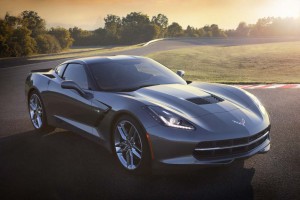
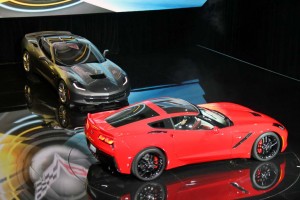
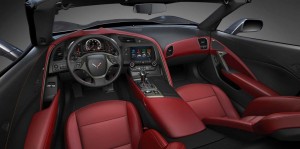
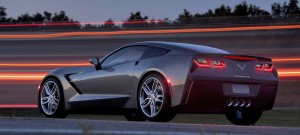
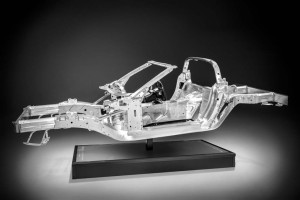
The C6 was an excellent step forward for Corvette. The C7 styling is a step backwards to the C6 IMO but the new tech in the C7 is cool. The Stingray fantasy is mostly marketing. Having driven the original ’63 Vette I can tell you it was cool looking but a PITA to see out the rear window and while highly desirable for it’s uniqueness, it’s not a particularly practical design for street or track.
What most folks miss in the comparison between a Porsche 911 and any other car is both the engineering prowess and durability. For literally the past 50 years you could take a 911 out of the showroom, drive it to Daytona, race a 24 hour race (and win or finish well if you have driving skill), then drive it home. It would still be running just fine after the 24 hour race and continue to run just fine for another 50 years if properly maintained. Very few other cars have ever been able to do that including Ferrari and other exotics.
Considering Porsche has been able to still maintain world leading performance from a rear engine car – which is far from the ideal design, it says a lot about their ability and dedication to true sportscars. The current configuration 911’s time as the ultimate sportscar is about to be surpassed by a mid-engine Porsche 911 model in years to come as the performance bar is constantly raised by the competition including Corvette.